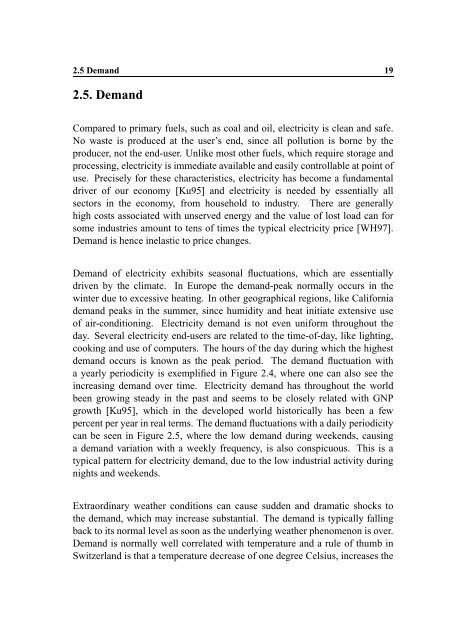Hedging Strategy and Electricity Contract Engineering - IFOR
Hedging Strategy and Electricity Contract Engineering - IFOR
Hedging Strategy and Electricity Contract Engineering - IFOR
Create successful ePaper yourself
Turn your PDF publications into a flip-book with our unique Google optimized e-Paper software.
2.5 Dem<strong>and</strong> 19<br />
2.5. Dem<strong>and</strong><br />
Compared to primary fuels, such as coal <strong>and</strong> oil, electricity is clean <strong>and</strong> safe.<br />
No waste is produced at the user’s end, since all pollution is borne by the<br />
producer, not the end-user. Unlike most other fuels, which require storage <strong>and</strong><br />
processing, electricity is immediate available <strong>and</strong> easily controllable at point of<br />
use. Precisely for these characteristics, electricity has become a fundamental<br />
driver of our economy [Ku95] <strong>and</strong> electricity is needed by essentially all<br />
sectors in the economy, from household to industry. There are generally<br />
high costs associated with unserved energy <strong>and</strong> the value of lost load can for<br />
some industries amount to tens of times the typical electricity price [WH97].<br />
Dem<strong>and</strong> is hence inelastic to price changes.<br />
Dem<strong>and</strong> of electricity exhibits seasonal fluctuations, which are essentially<br />
driven by the climate. In Europe the dem<strong>and</strong>-peak normally occurs in the<br />
winter due to excessive heating. In other geographical regions, like California<br />
dem<strong>and</strong> peaks in the summer, since humidity <strong>and</strong> heat initiate extensive use<br />
of air-conditioning. <strong>Electricity</strong> dem<strong>and</strong> is not even uniform throughout the<br />
day. Several electricity end-users are related to the time-of-day, like lighting,<br />
cooking <strong>and</strong> use of computers. The hours of the day during which the highest<br />
dem<strong>and</strong> occurs is known as the peak period. The dem<strong>and</strong> fluctuation with<br />
a yearly periodicity is exemplified in Figure 2.4, where one can also see the<br />
increasing dem<strong>and</strong> over time. <strong>Electricity</strong> dem<strong>and</strong> has throughout the world<br />
been growing steady in the past <strong>and</strong> seems to be closely related with GNP<br />
growth [Ku95], which in the developed world historically has been a few<br />
percent per year in real terms. The dem<strong>and</strong> fluctuations with a daily periodicity<br />
can be seen in Figure 2.5, where the low dem<strong>and</strong> during weekends, causing<br />
a dem<strong>and</strong> variation with a weekly frequency, is also conspicuous. This is a<br />
typical pattern for electricity dem<strong>and</strong>, due to the low industrial activity during<br />
nights <strong>and</strong> weekends.<br />
Extraordinary weather conditions can cause sudden <strong>and</strong> dramatic shocks to<br />
the dem<strong>and</strong>, which may increase substantial. The dem<strong>and</strong> is typically falling<br />
back to its normal level as soon as the underlying weather phenomenon is over.<br />
Dem<strong>and</strong> is normally well correlated with temperature <strong>and</strong> a rule of thumb in<br />
Switzerl<strong>and</strong> is that a temperature decrease of one degree Celsius, increases the
















